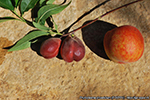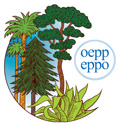
55th meeting of the Panel on Phytosanitary Measures
Paris, 2017-03-22/24
The Panel met in Paris in the EPPO headquarters on 2017-03-22/24. The main task of this Panel is to evaluate risks presented by specific pests and design phytosanitary measures to avoid their introduction and spread. The Panel had a joint session with the EPPO Panel on Quarantine Pests for Forestry to discuss issues of interest for both Panels: public awareness, development of the EPPO Standard on the concept and use of sentinel plants, possible development of a PM 9 Standard on Heterobasidion irregulare, necessity of PRA for Xylosandrus crassiusculus and combined PRA for Polygraphus proximus and Grosmannia aoshimae.
EPPO lists of pests recommended for regulation
The Panel reviewed in detail PRAs prepared by the Expert Working Groups (EWG) for PRA to agree on phytosanitary measures to be recommended for the pests concerned, and it also reviewed national PRAs.
The Panel recommended to the Working Party the addition of the following pests to the EPPO Lists:
- A1 List: Bactrocera latifrons, Prodiplosis longifila, Ceratothripoides brunneus and C. claratris, ‘Candidatus Phytoplasma phoenicium'
- A2 List: Meloidogyne mali, Thekopsora minima, Pomacea maculata and P. canaliculata, Platynota stultana, Citrus bark cracking viroid

‘Candidatus Phytoplasma phoenicium'

Thekopsora minima

Meloidogyne mali
The measures to prevent entry of Euwallacea fornicatus sensu lato and Fusarium euwallaceae were agreed. Following recent progress in taxonomy, the Panel recommended that Ralstonia pseudosolanacearum and R. syzygii should be added to A2 list. The Panel reviewed the present situation of A1 pests and considered that Xylella fastidiosa should be transferred from the A1 to the A2 List. The situation of Anthonomus eugenii and Anoplophora glabripennis should be reviewed next year.
Alert List
The Panel reviewed the EPPO Alert List (the purpose of this List is to warn countries about possible new risks, and in certain cases to propose candidates for PRA and eventually regulation). Considering that the alert had been given and that no further action was needed, the Panel decided to delete Agrilus auroguttatus, Diplocarpon mali, Hosta virus X, Tomato apical stunt pospiviroid. The Panel suggested some emerging pests that could be added to the Alert List (e.g. Ecdytolopha aurantianum, Citripestis sagittiferella, Crisicoccus pini).
Pest Risk Analysis
In addition to the review of PRAs (see above) the Panel established the priorities for the organization of EWGs for PRA. The selection was made taking into account the following elements: geographical distribution, importance of the crop(s) concerned, risk of natural spread into the region or for further spread within the region, potential pathways, economic impact, environmental impact, possibilities of control, similarities to other known cases, availability and validity of data. The Panel agreed that Rose rosette virus had a high priority, and Massicus raddei and Grapevine red blotch-associated virus a lower priority. This will be further discussed by the Working Party.
Guidance on buffer zones
The Panel discussed a first draft for a standard providing guidance on to define the optimal size of a buffer zone for a Pest-free Area or for eradication. This will be discussed further at the next meeting.
Soil and growing medium attached to plants for planting
The Panel considered the draft ISPM Movement of growing media in association with plants for planting in international trade (since adopted as ISPM 40 ![]() ) and agreed that the approach promoted in the draft ISPM is very similar to the recommendations made in 2015-11 by the Expert Working Group convened by EPPO. The main issues identified by the Panel in 2016 remain valid: the list of growing media considered safe is very limited (only inorganic media) compared to the growing media used in practice, and carrying out an evaluation of the other growing media will be very labour intensive. The priority of such an evaluation would be considered by the Working Party.
) and agreed that the approach promoted in the draft ISPM is very similar to the recommendations made in 2015-11 by the Expert Working Group convened by EPPO. The main issues identified by the Panel in 2016 remain valid: the list of growing media considered safe is very limited (only inorganic media) compared to the growing media used in practice, and carrying out an evaluation of the other growing media will be very labour intensive. The priority of such an evaluation would be considered by the Working Party.
Guidelines to establish pest lists in commodity PRAs
The Panel reviewed the comments made by Member Countries and finalized the Standard. It will be presented to the Working Party and Council for adoption.
Update on projects
The Panel was presented with the outcomes of the EU FP7 project DROPSA ![]() during which the EPPO Secretariat and JKI prepared alert lists of pests considered as likely to enter the EU with trade of Vaccinium fruit, oranges and mandarins, grapes and apple have been elaborated. These pests will be considered again at the next meeting. The Panel was also briefed about the progress of the Project on Regulated Non-Quarantine Pests (RNQPs).
during which the EPPO Secretariat and JKI prepared alert lists of pests considered as likely to enter the EU with trade of Vaccinium fruit, oranges and mandarins, grapes and apple have been elaborated. These pests will be considered again at the next meeting. The Panel was also briefed about the progress of the Project on Regulated Non-Quarantine Pests (RNQPs).
The new EFSA quantitative risk assessment methodology was presented, in particular how risk reducing options are integrated into it.
The next Panel meeting is planned 2017-10-09/11 in Brussels.
